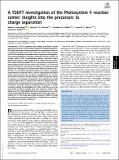Files in this item
A TDDFT investigation of the Photosystem II reaction center : Insights into the precursors to charge separation
Item metadata
| dc.contributor.author | Kavanagh, Maeve A. | |
| dc.contributor.author | Karlsson, Joshua K.G. | |
| dc.contributor.author | Colburn, Jonathan D. | |
| dc.contributor.author | Barter, Laura M.C. | |
| dc.contributor.author | Gould, Ian R. | |
| dc.date.accessioned | 2020-09-08T09:30:01Z | |
| dc.date.available | 2020-09-08T09:30:01Z | |
| dc.date.issued | 2020-08-18 | |
| dc.identifier | 269924361 | |
| dc.identifier | f51186ad-5486-4879-8777-c2042bd87084 | |
| dc.identifier | 85089787888 | |
| dc.identifier | 32747579 | |
| dc.identifier | 000570306900021 | |
| dc.identifier.citation | Kavanagh , M A , Karlsson , J K G , Colburn , J D , Barter , L M C & Gould , I R 2020 , ' A TDDFT investigation of the Photosystem II reaction center : Insights into the precursors to charge separation ' , Proceedings of the National Academy of Sciences of the United States of America , vol. 117 , no. 33 , pp. 19705-19712 . https://doi.org/10.1073/pnas.1922158117 | en |
| dc.identifier.issn | 0027-8424 | |
| dc.identifier.uri | https://hdl.handle.net/10023/20581 | |
| dc.description | Authors acknowledge the EPSRC for funding this research. | en |
| dc.description.abstract | Photosystem II (PS II) captures solar energy and directs charge separation (CS) across the thylakoid membrane during photosynthesis. The highly oxidizing, charge-separated state generated within its reaction center (RC) drives water oxidation. Spectroscopic studies on PS II RCs are difficult to interpret due to large spectral congestion, necessitating modeling to elucidate key spectral features. Herein, we present results from time-dependent density functional theory (TDDFT) calculations on the largest PS II RC model reported to date. This model explicitly includes six RC chromophores and both the chlorin phytol chains and the amino acid residues <6 Å from the pigments’ porphyrin ring centers. Comparing our wild-type model results with calculations on mutant D1-His-198-Ala and D2-His-197-Ala RCs, our simulated absorption-difference spectra reproduce experimentally observed shifts in known chlorophyll absorption bands, demonstrating the predictive capabilities of this model. We find that inclusion of both nearby residues and phytol chains is necessary to reproduce this behavior. Our calculations provide a unique opportunity to observe the molecular orbitals that contribute to the excited states that are precursors to CS. Strikingly, we observe two high oscillator strength, low-lying states, in which molecular orbitals are delocalized over ChlD1 and PheD1 as well as one weaker oscillator strength state with molecular orbitals delocalized over the P chlorophylls. Both these configurations are a match for previously identified exciton–charge transfer states (ChlD1+PheD1−)* and (PD2+PD1−)*. Our results demonstrate the power of TDDFT as a tool, for studies of natural photosynthesis, or indeed future studies of artificial photosynthetic complexes. | |
| dc.format.extent | 8 | |
| dc.format.extent | 1808409 | |
| dc.language.iso | eng | |
| dc.relation.ispartof | Proceedings of the National Academy of Sciences of the United States of America | en |
| dc.subject | Charge-separation precursors | en |
| dc.subject | Photosynthesis | en |
| dc.subject | Photosystem II | en |
| dc.subject | Structure–function relationship | en |
| dc.subject | TDDFT | en |
| dc.subject | QD Chemistry | en |
| dc.subject | DAS | en |
| dc.subject.lcc | QD | en |
| dc.title | A TDDFT investigation of the Photosystem II reaction center : Insights into the precursors to charge separation | en |
| dc.type | Journal article | en |
| dc.contributor.institution | University of St Andrews. School of Chemistry | en |
| dc.identifier.doi | 10.1073/pnas.1922158117 | |
| dc.description.status | Peer reviewed | en |
| dc.identifier.url | https://www.pnas.org/lookup/suppl/doi:10.1073/pnas.1922158117/-/DCSupplemental | en |
This item appears in the following Collection(s)
Items in the St Andrews Research Repository are protected by copyright, with all rights reserved, unless otherwise indicated.

